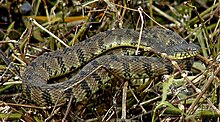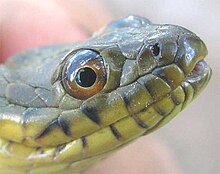Nerodia rhombifer
| Nerodia rhombifer | |
|---|---|

| |
| Scientific classification | |
| Domain: | Eukaryota |
| Kingdom: | Animalia |
| Phylum: | Chordata |
| Class: | Reptilia |
| Order: | Squamata |
| Suborder: | Serpentes |
| Family: | Colubridae |
| Genus: | Nerodia |
| Species: | N. rhombifer
|
| Binomial name | |
| Nerodia rhombifer (Hallowell, 1852)
| |
| Subspecies | |
|
N. r. blanchardi (Clay, 1938) | |
| Synonyms | |
| |

Nerodia rhombifer, commonly known as the diamondback water snake, is a

Taxonomy and systematics
The species was first described as Tropidonotus rhombifer by Edward Hallowell in 1852.
Description
The diamondback water snake is predominantly brown, dark brown, or dark olive green in color, with a black net-like pattern along the back, with each spot being vaguely diamond-shaped. Dark vertical bars and lighter coloring are often present down the sides of the snake. In typical counter-colored fashion, the underside is generally a yellow or lighter brown color, often with black blotching.
The
Adult males have multiple papillae (tubercles) on the under surface of the chin, which are not found on any other species of snake in the United States.[4]
Nerodia rhombifer grows to an average total length (including tail) of 76–122 cm (30–48 inches). The record total length is 180 cm (69 inches).[5]
Neonates are often lighter in color, making their patterns more pronounced, and they darken with age.
Habitat
The diamondback water snake is one of the most common species of snake within its range. It is found predominantly near slow-moving bodies of water such as streams, rivers, ponds, or swamps.
Behavior
When foraging for food the diamondback water snake will hang on branches suspended over the water, dipping its head under the surface of the water, until it encounters a fish or other prey. It is frequently found basking on branches over water, and when approached, it will quickly drop into the water and swim away. If cornered, it will often hiss, and flatten the head and body to appear larger. It only typically resorts to biting if physically harassed or handled. Its bite is known to be quite painful due to its sharp
Geographic range
The diamondback water snake is found in the central United States, predominantly along the Mississippi River valley, but its range extends beyond that. It ranges within the states of Texas, Oklahoma, Kansas, Iowa, Louisiana, Arkansas, Missouri, Illinois, Indiana, Tennessee, Mississippi, Georgia, and Alabama. It is also found in northern Mexico, in the states of Coahuila, Nuevo León, Tamaulipas, and Veracruz.
This snake has been introduced to
Reproduction
Like other Nerodia species, the diamondback water snake is
Conservation concerns
While not endangered or threatened, the main threat to N. rhombifer is human ignorance. The diamondback water snake is often mistaken for the cottonmouth or rattlesnakes and is killed out of fear. In actuality, the diamondback water snake and other species of water snakes are far more common than the venomous snakes in their range, especially in areas that are frequented by humans.[citation needed]
In captivity
Due to how common the species is, the diamondback water snake is frequently found in captivity in states where it is legal to keep native reptiles in captivity, though there is little market value for it in the
References
- .
- ^ Stejneger L, Barbour T (1917). A Check List of North American Amphibians and Reptiles. Harvard University Press. Cambridge, Massachusetts: Harvard University Press. 125 pp. (Natrix rhombifera, p. 95).
- ^ ISBN 0-307-13666-3. (Nerodia rhombifera, pp. 154-155).
- ISBN 0-395-19977-8(paperback). (Natrix rhombifera rhombifera, p. 142, Figure 34 + Plate 21 + Map 104).
- ISBN 0-544-12997-0(paperback). (Nerodia rhombifer, pp. 419-420, Figure 191 + Plate 41).
- ^ Nafis, Gary (2000–2017). "Alien Reptiles and Amphibians Introduced Into California". CaliforniaHerps.com — A Guide to the Amphibians and Reptiles of California. Retrieved 30 November 2017.
Further reading
- ISBN 0-394-50824-6. (Nerodia rhombifera, pp. 636-637 + Plate 574).
- Cagle FR (1937). "Notes on Natrix rhombifera as observed at Reelfoot Lake". Journ. Tennessee Acad. Sci. 12: 179-185.
- Clay WM (1938). "A new water snake of the genus Natrix from Mexico". Annals of the Carnegie Museum 27: 251-255. (Natrix rhombifera blanchardi, new subspecies).
- Conant R (1953). "Three new water snakes of the genus Natrix from Mexico". Natural History Miscellanea 126: 1-9. (Natrix rhombifera werleri, new subspecies, p. 4).
- Conant R, Bridges W (1939). What Snake Is That? A Field Guide to the Snakes of the United States East of the Rocky Mountains. (With 108 drawings by Edmond Malnate). New York and London: D. Appleton-Century. Frontispiece map + viii + 163 pp. + Plates A-C, 1-32. (Natrix rhombifera rhombifera, p. 96 + Plate 17, figure 48).
- ISBN 978-0806135991.
- Hallowell E (1852). "Descriptions of new species of reptiles inhabiting North America". Proc. Acad. Nat. Sci. Philadelphia 6: 177-182. (Tropidonotus rhombifer, new species, p. 177).
- Schmidt KP, Davis DD (1941). Field Book of Snakes of the United States and Canada. New York: G.P. Putnam's Sons. 365 pp. (Natrix rhombifera rhombifera, pp. 217–218, Figure 71 + Plate 23, Bottom, on p. 343).
- Wright AH, Wright AA (1957). Handbook of Snakes of the United States and Canada. Ithaca and London: Comstock. 1,105 pp. (in 2 volumes). (Natrix rhombifera rhombifera, pp. 500–504, Figure 147, Map 41.)
External links
- Species Nerodia rhombifer at The Reptile Database
- Diamondback Water Snake, Reptiles and Amphibians of Iowa

